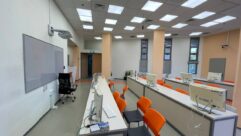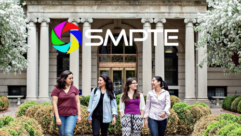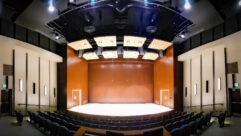Committee Will Explore and Standardize New Sound Measurement Techniques With the Goal of Consistent Sound Reproduction
WHITE PLAINS, N.Y. — March 4, 2013 — The Society of Motion Picture and Television Engineers (SMPTE), the worldwide leader in motion-imaging standards and education for the communications, media, entertainment, and technology industries, today announced the creation of a new technology committee, TC-25CSS, dedicated to cinema sound. The committee will work to update SMPTE standards and recommended practices to address opportunities created by the many technical advances since standards last were created, as well as to improve the quality and consistency of cinema sound.
“Improvements in measurement technology, digital sound delivery, and in sound reproduction equipment, as well as the greater detail and dynamic range of movie soundtracks, present a variety of challenges in providing quality cinema sound,” said Brian Vessa, executive director of digital audio mastering at Sony Pictures Entertainment and chair of the new SMPTE committee.
“Existing SMPTE standards and recommended practices help to minimize variations, but cinema sound quality today is highly dependent on the skill, talent, training, and hearing acuity of the adjusting technician,” added Vessa. “TC-25CSS, the first SMPTE technology committee dedicated solely to cinema sound, will explore and standardize new sound measurement techniques with the goal of consistency in sound reproduction between the mixing stage and diverse cinema spaces.”
TC-25CSS was formed following an extensive study by the Theater B-Chain Study Group, which conducted tests of current test equipment and methods, measured reference and commercial theaters, and collaborated on observations and results. The committee currently has 130 members, representing more than 90 companies and academic institutions from 14 countries.
“The introduction of Digital Cinema is helping to provide a consistently high quality of image display. Sound is at least as important in the movie theater experience,” said Hans Hoffmann, head of production technology for the EBU and SMPTE standards vice president. “The Cinema Sound Systems committee will work to ensure that the latest science and technology are used to allow cinema-goers to enjoy the full impact of the sound experience as created in the mixing room.”
As TC-25CSS works to standardize techniques and tools for optimizing sound systems and theater acoustics, the committee will correlate human sound perception with the science of sound reproduction and measurements as the underlying principle. Current activities include development of a recommended practice for measurement and calibration of B-chain sound systems using modern standards and measurement technology, creation of a standard pink noise test signal, a final report on data and findings from the Theater B-Chain Study Group, and work by two new study groups examining immersive audio systems and new electroacoustic measurement methods and target curves.
“This is the first time since the late ’70s that cinema sound has been addressed in depth,” said Mark F. Collins, director of projection technology for Marcus Theatres. “Over the past three decades, we’ve seen huge changes in audio technology, and our hope is that, through the work of the new SMPTE technology committee and its subcommittees, the tools used to measure audio signals will be brought into tune with today’s technology. With signal-testing tools that support very consistent audio quality throughout the industry, cinema owners can provide very good presentations and assure movie creators that what’s being reproduced in the field is consistent with the studio mix.”
In the upcoming SMPTE Standards Webcast “Cinema Sound Systems — Raising the Bar Through New Standards,” scheduled for March 12, Vessa will discuss topics including current SMPTE standards, the new committee’s work, and the impact of new and emerging immersive cinema sound systems on the standards-creation process. The webcast is free and open to all. Those interested in registering may do so at
www.smpte.org/education/standards-webcasts
.
# # #
About the Society of Motion Picture and Television Engineers
The Oscar(R) and Emmy(R) Award-winning Society of Motion Picture and Television Engineers (SMPTE), a professional membership association, is the worldwide leader in developing and providing motion-imaging standards and education for the communications, technology, media, and entertainment industries. An internationally recognized and accredited organization, SMPTE advances moving-imagery education and engineering across the broadband, broadcast, cinema, and IT disciplines. Since its founding in 1916, SMPTE has published the SMPTE Motion Imaging Journal and developed more than 600 standards, recommended practices, and engineering guidelines. SMPTE members include motion-imaging executives, engineers, creative and technology professionals, researchers, scientists, educators, and students from around the world. Information on joining SMPTE is available at
.










